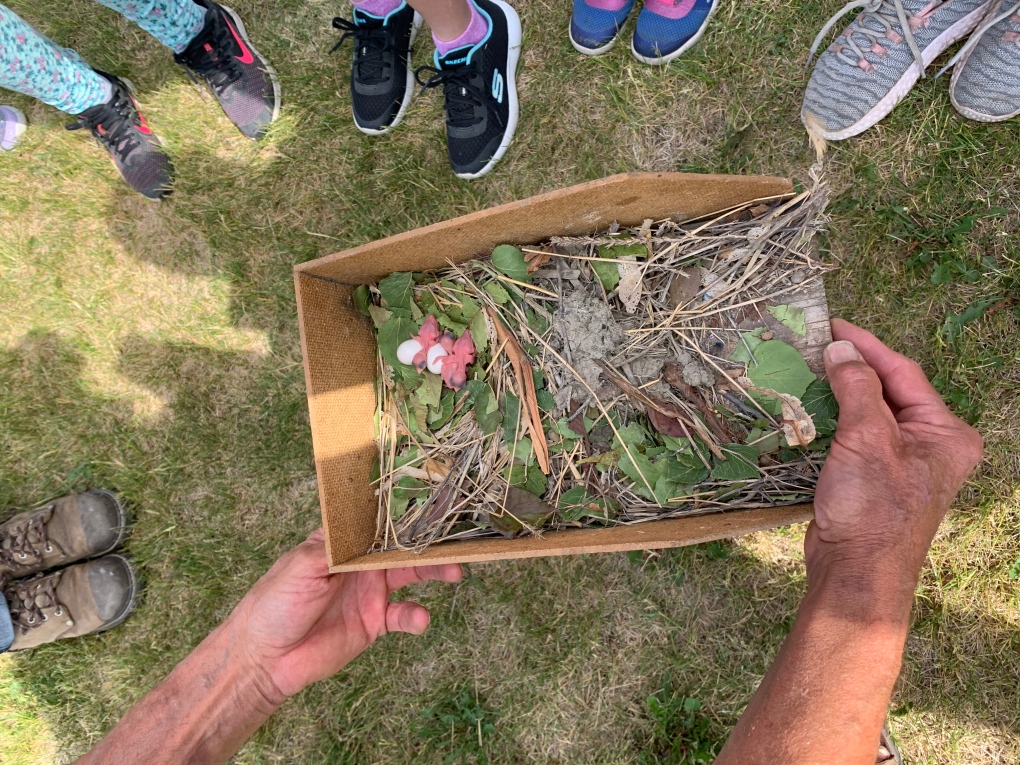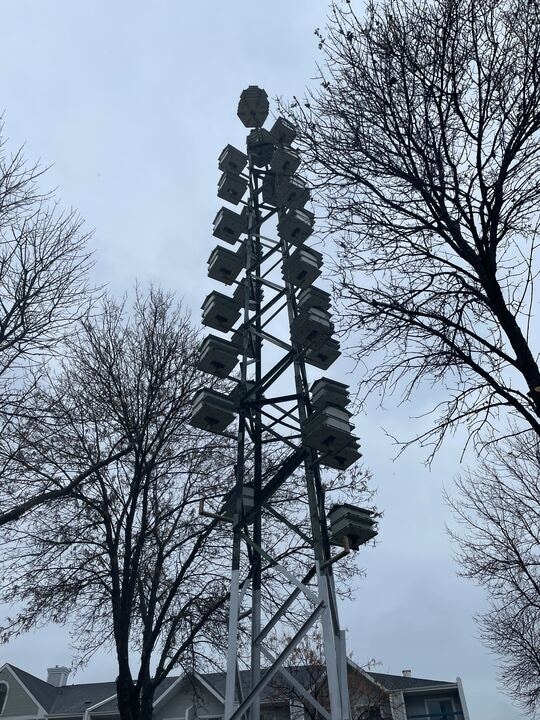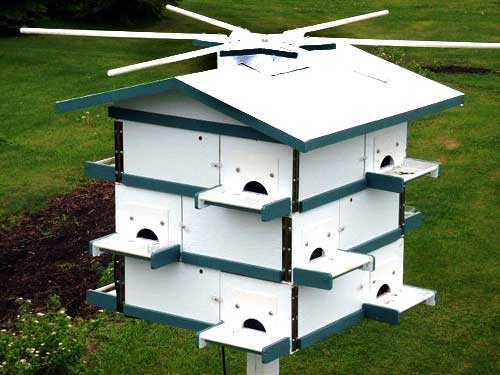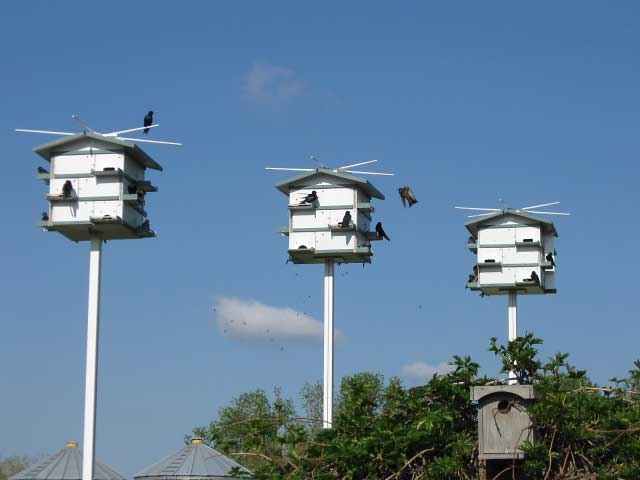'A special bird': The unbreakable bond between purple martins and humans
 A flock of purple martins flying around a bird house in Brandon. Uploaded May 19, 2024. (Dave Barnes)
A flock of purple martins flying around a bird house in Brandon. Uploaded May 19, 2024. (Dave Barnes)
Flashes of purple darting across the sky mixed with the serenading sound of songs will be noticed more with spring in full force in Manitoba.
Purple martins have returned to North America – including the Canadian prairies – for their breeding season, a celebratory sight for bird lovers in the province.
Dave Barnes has admired the bird from a young age and is now one of the many birdwatchers who eagerly await their return every spring.
For Barnes, his favourite aspect about purple martins is the connection they have with humans.
"Humans have established a long-term relationship with purple martins," said Barnes.
He said the beautiful songbirds have become reliant on humans to provide shelter – dating back hundreds of years.
"It's thought that Indigenous ancestors put up these poles with gourds, hollowed out gourds on them to attract the martins to nest."
Barnes notes this wasn't just a one-way relationship. The nests would be set up around crops and since martins are insectivores, they would keep bugs away.
They are also very defensive of their nests according to Barnes, so they would keep other birds from settling in and eating the growing plants.
"There's not a lot of birds that can catch them and when they are mounting, you've got 50 to 100 of these (martins) dive-bombing a crow, it's time to move along.
"So the martins would protect the seed in their gardens…They would not let crows or blackbirds come and hang around."
 Dave Barnes holds one of the nest trays from a purple martin birdhouse. Inside are freshly hatched baby purple martins. Uploaded May 19, 2024. (Dave Barnes)
Dave Barnes holds one of the nest trays from a purple martin birdhouse. Inside are freshly hatched baby purple martins. Uploaded May 19, 2024. (Dave Barnes)
That relationship has continued to blossom over the years, with people – now known as purple martin landlords – taking care of colonies of martins.
Barnes is one of those landlords and currently looks after the largest purple martin colony in Brandon, Man.
"We supply 48 apartments in four castles on four poles. On a good summer, we will fledge up to 200 young martins, (flying) off into the sky."
These purple martin apartments or condos have transformed over the years from the aforementioned gourdes to these "castles" that can be seen scattered throughout the country.
Barnes said one that people might be familiar with is the aluminum tower in Gimli, Man. that has dozens of purple martin houses attached.
 The purple martin tower in Gimli, Man. April 26, 2024. (Alexandra Holyk/CTV News Winnipeg)
The purple martin tower in Gimli, Man. April 26, 2024. (Alexandra Holyk/CTV News Winnipeg)
However, they aren't too common anymore.
"Those are already dinosaur artifacts, those towers," said Barnes.
He said there are around five of the towers throughout Manitoba, but they have become less of a home for purple martins and have been taken over by other birds like swallows.
For those that are still inhabited by martins, Barnes notes they can be difficult to clean out as there isn't an easy way to access them.
"The trick with those darn towers is they are not made to be climbed. You can't get up there to clean out old sparrow nesting."
One of the people who helped revolutionize homes for purple martins was Bob Buskas.
The Wetaskiwin, Alta. native said his fascination with the bird started around 1996. He liked the challenge of starting a colony while flexing his woodworking ability to build new birdhouses.
When he first started the hobby, he found there were a number of limitations with the houses.
"The houses were not adequate for the most part. None of them could raise or lower on a winch or anything, so they were hard to manage. The compartments were too small…with round entrance holes that were too small for the martins," said Buskas.
So Buskas got to work designing a home he thought would be appropriate for the bird, and in 2000 he built his very first North Star house.
 A North Star bird house for purple martins created by Bob Buskas. May 19, 2024. (Bob Buskas/northernskys.ca)
A North Star bird house for purple martins created by Bob Buskas. May 19, 2024. (Bob Buskas/northernskys.ca)
There can be up to 12 apartments on each house and each compartment has a door to make them easily accessible and the tray slides out to make them easier to clean.
Buskas also designed them so they can go up and down easily on a wooden or metal pole.
Now, every winter, he builds around eight to 12 of the houses to be sold. As well, he sells houses that have been cut but still need to be built, and a number of people have bought his blueprints so they can make their own North Star house.
 A trio of North Star bird houses inhabited by purple martins. May 19, 2024. (Bob Buskas/northernskys.ca)
A trio of North Star bird houses inhabited by purple martins. May 19, 2024. (Bob Buskas/northernskys.ca)
"In the U.S., I've sold quite a few plans for the house down there," said Buskas. "But mostly my North Star house is a Canadian thing."
Gordon Oleksuk from Elie, Man. has been doing his part to make sure the martins have had a place to live.
The retired carpenter said he has built more than 300 houses and they are scattered throughout Manitoba. He noted he always had an interest in purple martins, and building them houses was the perfect hobby for him once he retired.
"They're kind of interesting. They usually come back to the same nest year after year, and it's good to keep track of them. They get quite tame," said Oleksuk.
He had a lot of success building the houses, saying the birds would call them home right away.
"It would always seem to attract them. Anybody that bought a house, if they ever called me back, they said they had birds right away, the first year.
The almost 90-year-old hasn't made a house in about 10 years, but he can still spot his work whenever he is taking a trip throughout the province.
"If you look after (the houses) they will last."
That's a sentiment shared by both Barnes and Buskas when talking about the birds, saying people need to do everything they can to ensure this bird continues to thrive.
"I love to be invested in habitat provision," said Barnes. "The purple martin is a special bird."
CTVNews.ca Top Stories

W5 Investigates A 'ticking time bomb': Inside Syria's toughest prison holding accused high-ranking ISIS members
In the last of a three-part investigation, W5's Avery Haines was given rare access to a Syrian prison, where thousands of accused high-ranking ISIS members are being held.
As Australia bans social media for children, Quebec is paying close attention
As Australia moves to ban social media for children under 16, Quebec is debating whether to follow suit.
Irregular sleep patterns may raise risk of heart attack and stroke, study suggests
Sleeping and waking up at different times is associated with an increased risk of heart attack and stroke, even for people who get the recommended amount of sleep, according to new research.
California man who went missing for 25 years found after sister sees his picture in the news
It’s a Thanksgiving miracle for one California family after a man who went missing in 1999 was found 25 years later when his sister saw a photo of him in an online article, authorities said.
Trudeau Liberals' two-month GST holiday bill passes the House, off to the Senate
The federal government's five-page piece of legislation to enact Prime Minister Justin Trudeau's promised two-month tax break on a range of consumer goods over the holidays passed in the House of Commons late Thursday.
Notre Dame Cathedral: Sneak peek ahead of the reopening
After more than five years of frenetic reconstruction work, Notre Dame Cathedral showed its new self to the world Friday, with rebuilt soaring ceilings and creamy good-as-new stonework erasing somber memories of its devastating fire in 2019.
Canada Post temporarily laying off striking workers, union says
The union representing Canada Post workers says the Crown corporation has been laying off striking employees as the labour action by more than 55,000 workers approaches the two-week mark.
Can't resist Black Friday weekend deals? How to shop while staying within your budget
A budgeting expert says there are a number of ways shoppers can avoid getting enveloped by the sales frenzy and resist spending beyond their means.
Montreal shopping mall playing 'Baby Shark' song to prevent unhoused from loitering
A shopping mall and office complex in downtown Montreal is being criticized for using the popular children's song 'Baby Shark' to discourage unhoused people from loitering in its emergency exit stairwells.


































